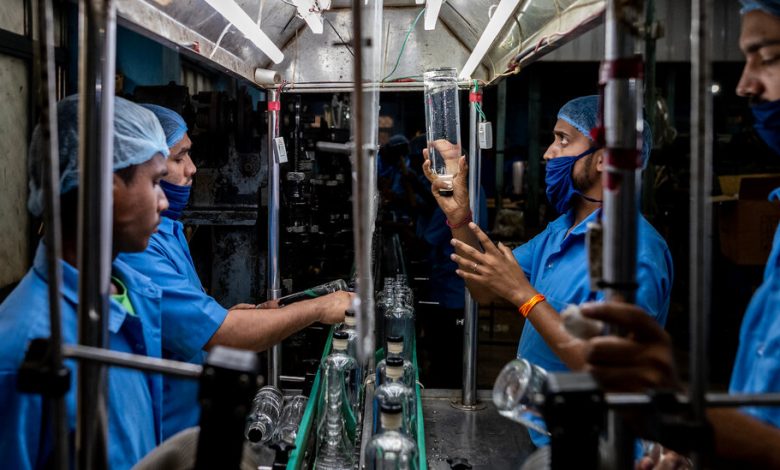The Gin Boom Trying to Change India, One Distillery at a Time

The room was small, no bigger than a garage, buried in the hills of India’s lush and liberal state of Goa, and Siddharth Girimon was busy crafting gin. On a Ping-Pong table shoved against the wall, a mound of green cardamom shells from western India had been hand-peeled like pistachios. A glass kit for flavor experiments sat on a shelf, and on the other side of the distillery, the day’s run dripped from a copper still into a steel canister.
Clear and fragrant, it was on its way to becoming another 70 cases of what Mr. Girimon and his boss hoped would tell a new kind of story about India — steeped in history, but also showing off the creativity of a young, more modern generation.
“The idea behind it was to use only Indian botanicals,” said Mr. Girimon, 25, a distiller who resembles a chemistry student, with glasses, long hair and oceans of enthusiasm for a narrow subject. “We wanted to show what India could do with gin.”
From Japan to Kenya, the world is already awash in craft spirits movements, but the blossoming of gin in Goa offers more than a nod to shifting market tastes. The local concoctions are challenging India’s conservative attitude toward alcohol, along with the country’s often stultifying bureaucracy, while prompting weightier questions: Can national pride be drawn from a bottle? Can innovation in spirits change how India thinks of itself and how the world sees India?
Mr. Girimon’s company, Nao Spirits, is one of dozens that have suddenly emerged. The gin on tap during a recent visit was premium stuff called Hapusa, the Sanskrit word for juniper. Those little berries have been the key ingredient in gin since it was first made in 16th-century Holland, when it carried the name “genever.”
Many gin connoisseurs insist that the best juniper comes from Macedonia; Hapusa argues otherwise, relying on larger juniper berries foraged from the Himalayas along with other native ingredients, including turmeric, raw mango and ginger.
When Nao Spirits first produced a small-batch gin from Goa in 2017, partnering with a local bottler to get a state permit, no one seemed to have made the connection between India, the cradle of the spice trade for centuries, and gin, which is really just a blank canvas of alcohol with herbs and other plants used to brighten the portrait.
Only a few years later, Goan gin has become a bountiful and colorful bouquet. Pumori gin — named after Mount Pumori, a few miles west of Mount Everest — also uses Himalayan juniper, along with other local botanicals. Jin Jiji relies on Indian juniper, adding a Goan specialty, cashew nuts, while Matinee gin includes Goan peppercorn. Samsara and GinGin also use native Indian ingredients, including a touch of hemp.
More on India
- On the Big Screen: A Mumbai theater has shown the movie “D.D.L.J.” nearly every day since 1995. In many ways, the India of today looks like the India on the screen.
- India’s Cram City: In Kota, students from across the country pay steep fees to be tutored for elite-college admissions exams — which most of them will fail.
- Renting as a Single Woman: As they delay or reject marriage and live on their own, single working women in India face an often infuriating quest for housing.
- Modi Documentary: The Indian government is trying to prevent a BBC documentary about Prime Minister Narendra Modi from being viewed in India. Students across the country are fighting back.
All of this gin growth has arrived in a country that has never really had a strong culture of alcohol — India is often called the home of the gin and tonic, but that was a British thing.
India’s 1948 Constitution actually directed states to work toward the prohibition of intoxicating drinks and drugs. A handful of them, including Gujarat, the home state of Prime Minister Narendra Modi, currently prohibit the sale and consumption of alcohol. Other areas have tried prohibition then given up, but in most of India, even drinking a cocktail at home is still so taboo that small bottles, nips of a few ounces, make up the majority of liquor sales.
Goa, however, is more permissive. A small coastal state in the south, it was a Portuguese territory until 1961. The state is more Christian, with churches painted wedding white and canary yellow brightening the winding rural roads. And for reasons that go beyond religion — Goa has been a center of global trade since the 16th century — its people have prided themselves on being more open-minded about all kinds of things.
That includes drinking.
Drive around Goa for an hour and the contrast is obvious: Large bottles can be seen from the streets in the windows of liquor stores. Bars cluster together, and taxes on alcohol are as little as a tenth of what must be paid in other states that work harder to discourage drinking.
“Goans are just different,” said Hansel Vaz, whose family owns the leading liquor distribution company in Goa, and who is himself a distiller of feni, a local liquor made from cashew flowers or coconut. “With every fiber of our being.”
His own liquor store, near Margao, features a wide floor-to-ceiling shelf with about 60 brands of gin, nearly half of them local. Among those, many can be bought only in Goa because other states have been hesitant to give distillers licenses for sales.
In north Goa, Khalil Bachooali and his wife, Devika Bhagat, are hoping they can change that by lobbying officials for a loosening of the regulatory shackles.
On a tour of the Adventurist Spirits distillery, where they make Tamras gin and recently opened a chic visitors center for tastings, Mr. Bachooali argued that Indian gin should be clearly defined and separated from the “Indian-made foreign liquor” category of the law. The best way to make it happen, he added, might be for craft gins to succeed overseas.
Many of them, including Tamras, Hapusa and Stranger and Sons, another popular gin, have already started to win international awards. Global markets seem to be welcoming them. Hapusa is now sold in the United States. Tamras will be available next month in the Maldives and Turkey — before, Mr. Bachooali notes, it can be bought in Delhi.
“India loves to export,” he said, standing behind the bar in the distillery. “Once we export and establish ourselves abroad, we take that case study and we bring it back here.”
Through two hours of talking — about gin’s history and India’s bureaucracy, about how he and his wife, a successful screenwriter, got into the distilling business after being asked by a London bartender what India’s “gin scene” looked like — Mr. Bachooali made clear that he had seen a pitch meeting or two. His still works mainly as a producer of films and commercials, and he knew just when to pause or slap both hands on the bar for emphasis.
That kind of salesmanship has entered the nightlife culture in Goa, as well. Near the coast, at a hip new restaurant and beach club called Thalassa, with a tan and white palette suggesting Miami or Mykonos, the wall behind the bar shined bright lights on local gin. The drinks menu featured “local spirits-based mixology.”
Jatin Thakur, 21, had arrived there for his first bartender job a few months earlier, from a small town near the Himalayas. “I come from the snow,” he said.
Like Mr. Girimon making Hapusa, he had moved to Goa for something different — a more tolerant, enterprising mind-set. Maybe it is just the spirits talking, but India’s gintrepreneurs are also hoping their craft will help the world see India as more than a land of tigers, elephants and ancient religion.
“This is modern India,” said Anand Virmani, 35, a founder of Nao Spirits, which recently released a gin smoked with the wood from Indian cricket bats. “What we want to do is create unique things, unique stories that represent us as a modern country. And I emphasize modern.”




